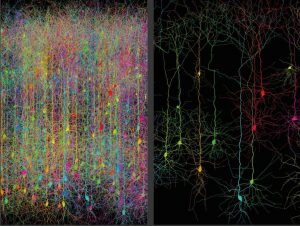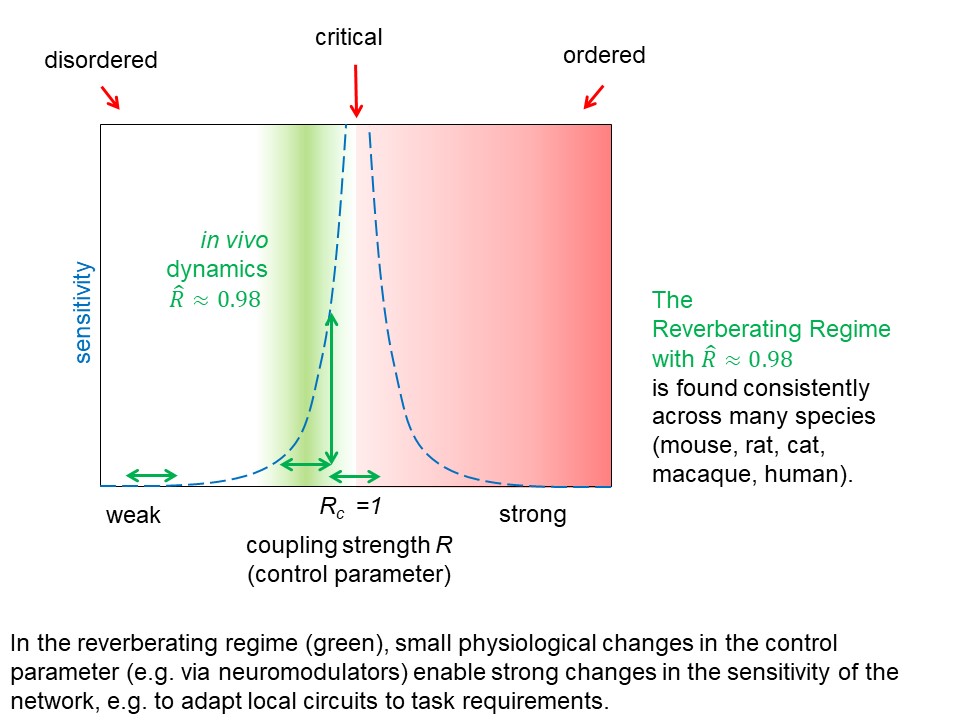(As of 2020/12)
I. Subsampling Theory. To study large, complex networks, we need to sample their activity. However, in the brain like in most large systems, it is impossible to sample the activity of all units in parallel. The human brain for example comprises 80 billion neurons, but current techniques allow sampling the activity from only a few thousand neurons at a time. How can one infer properties from the full system if only observing a tiny fraction? Importantly, naive inferences about the full system can lead to systematic biases and hence misinterpretations. We develop approaches to overcome subsampling effects in the context of network theory, and of non-equilibrium phase transitions. Developing such a subsampling theory is necessary to infer the functioning of learning living networks.
Selected References:
Priesemann et al., Frontiers in Systems Neuroscience (2014)
Levina & VP, Nature Communications (2017)
Wilting &VP, Nature Communications (2018)
Levina, Zierenberg & Priesemann, Nature Review Physics (2022)

II. Reverberating, Subcritical Dynamics in vivo. In neuroscience, a popular hypothesis states that the collective neural dynamics should self-organize to a critical state, because at criticality simple models maximize their information-processing capacities. However, criticality may also come with the risk of spontaneous runaway activity (epilepsy). I obtained clear evidence that neural dynamics maintains a distance to criticality, and thereby keeps a safety margin to runaway activity. This distance to criticality is consistent across different species, but changes from wakefulness to deep sleep. Most recently, I succeeded in taming the out-of-equilibrium effects imposed by ongoing external stimulation, and as a result, developed a very effective method to quantify the distance to criticality from very little data. This opens novel avenues to study how networks tune their distance to criticality – and hence their information processing – from one moment to the other, depending on task requirement and context.
Selected References:
Cramer et int., Priesemann, Nature Communications (2020)
Priesemann et al., Plos Comp. Biol. (2013)
Wilting & Priesemann, Cerebral Cortex (2019)
Wilting & Priesemann, Current Opinion Neurobiol. (2019)
Zierenberg, Wilting & Priesemann, Physical Review X (2018)

III. Information Theory. Information theory is the natural language to quantify computation. I employ it in two complementary manners: To infer the coding principles of living neural networks, which were developed, tested and selected over millions of years of evolution, and to design networks for optimized processing from first principles. Going a step further, we do not only design the networks directly, but we derive the learning rules that shape the network autonomously. In this realm, information theory provides the ideal language, because it is independent of semantics. Thereby it enables a comparison of coding principles across very diverse architectures and implementations. This is useful when e.g. comparing coding across species and areas, where it has been key to unravel a clear hierarchy of processing across cortex. Our ongoing/future work goes into the role of phase transitions in information processing; local learning as a form of symmetry breaking; architectures to optimize Gibbs sampling despite strong correlations; and invariance of information flow under coarse-graining.
Selected References:
Wibral, Lizier & Priesemann, Frontiers in Robotics and AI (2015)
Wibral, Finn, Wollstadt, Lizier, Priesemann, Entropy (2017)
Wollstadt et al., PLOS Computational Biology (2017)

Figure from Wibral et al (2017).
IV. Epidemics and Infodemics. With the outbreak of COVID-19, it turned out that our work on spreading dynamics in the brain is highly valuable to investigate the spread of SARS-CoV-2. During the pandemic, not only the spread of the virus, but also that of news and fake news (“infodemic“) challenged societies. We are studying the interaction of pandemic and infodemic spread using the example of the COVID-19 pandemic because of the abundance of disease and news data. Understanding the spread of (mis)information will be crucial when facing any future crises.
In more detail, (1) we have already shown how the information about the viral spread can mitigate the extend of pandemic waves. (2) We investigated how the reproduction number R changes as a consequence of a certain intervention like e.g. closing schools or imposing a contact ban. (3) We then continued to investigate the challenges when mitigating COVID-19 spread via test-trace-isolate strategies. These strategies are inherently imperfect, and their capacity is limited. Hence, we identified an important tipping point: If case numbers are too high, so that a local health authority cannot test and trace the contacts anymore, and thus are too slow to break the infection chains, we see increasingly more unaware carriers. These unaware carriers are the drivers of a self-accelerating spread. The conclusion is straightforward: If case numbers are low, a control of the spread is much easier. Beyond the tipping point, regaining control becomes increasingly more difficult.
In parallel, we are developing a hierarchical Bayesian model to investigate the impact of non-pharmaceutical interventions (NPIs) using European as well as federal data.
Based on this research, I became a member of the national expert panel on COVID-19 of the federal government (Expertenrat). I initiated a series of international, interdisciplinary consensus statements that were published e.g. by The Lancet, and I co-authored several statements that were published by the presidents of the Fraunhofer, Helmholtz, Leibniz and Max Planck Society, or by the Leopoldina.
Selected References:
Alwan et al., The Lancet, 2020
Bauer et int., VP, Plos Computational Biology, 2021
Contreras et int., VP, Nature Communications, 2021 / arxiv
Contreras et int., VP, Science Advances, 2021
Dehning et int., VP, Science, 2020/ arxiv
Dehning et int., VP, medrxiv
Linden et int., VP, Deutsches Ärzteblatt Int., 2020 / arxiv
Priesemann et al., The Lancet, 2021a,b,c
Github: https://github.com/Priesemann-Group/
Meyer-Hermmann*, Pigeot*, Priesemann*, Schöbel*: Adaptive Strategien zur Eindämmung der COVID-19 Epidemie
Meyer-Hermmann*, Pigeot*, Priesemann*, Schöbel*: Gemeinsam können wir es schaffen: Jeder einzelne Beitrag schützt Gesundheit, Gesellschaft und Wirtschaft
V. Music. Long-range correlations characterize neural activity in the brain. Therefore music, which may be considered the mirror of the soul or the brain, should also reflect these correlations. In collaboration with Theo Geisel, we investigate how long-range correlations and information-theoretic quantities change with genres, and whether long-range correlations play a central role in making Swing swing.
References:
Sogorski, Geisel & VP, Plos ONE (2018)
Datseris et al., arxiv / in press (2019)
